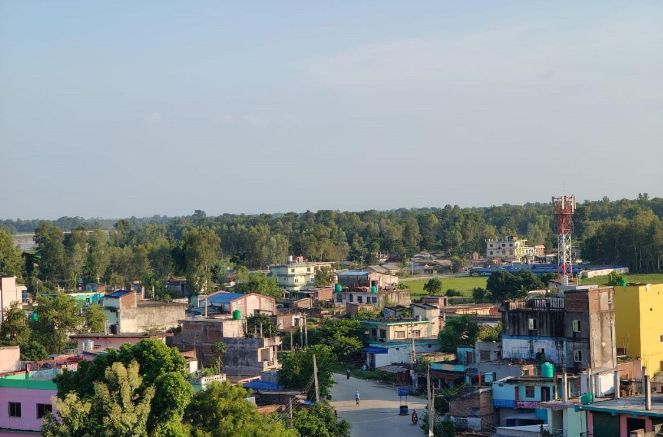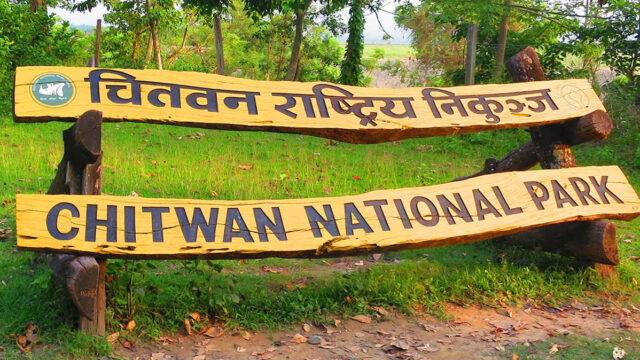Bhajani Market in Kailali District, once the old district headquarters, has a history that may not resonate with the current generation. For many young people today, the idea of Bhajani as the district’s administrative center is hard to believe, given the shortages and challenges it faces now.
Until 1981, several government offices were located in Bhajani. Many structures built during that time still stand today, though the residents have been grappling with natural disasters and various challenges for decades. The area faces significant threats from floods, riverbank erosion, and inundation during the monsoon season, displacing hundreds of families. Bhajani, encircled by rivers like Kandara, Mohana, Kaha, and Patharaya, is particularly vulnerable to flooding.
Kailali Municipality Mayor Kewal Chaudhary emphasized, “If we can find a sustainable solution to the flooding and inundation issues, it could greatly enhance the development of this area. However, our resources are insufficient to keep Bhajani afloat. The central and provincial governments have not been able to comprehend and address our suffering.”
As local rivers and streams continue to rise each year, Bhajani suffers from flooding even during moderate rainfall, according to municipal spokesperson Bikram Chaudhary. “The construction of the Hulaki Highway has contributed to the flooding problem by blocking rainwater,” he stated. “Flooding has also occurred when the gates of a dam built on the Ghaghara River, just 8 to 10 kilometers from the international border, are closed, affecting areas including Bhajani.”
Local residents have expressed concerns that due to river erosion and flooding, some villages may need to be relocated. Once a significant player in rice exports to countries like India, Bangladesh, and Sri Lanka, Bhajani’s rice mill has long been closed. Among the two customs offices in the border area, the Kusumghat customs office has also ceased operations.
“Efforts must be made to develop a comprehensive master plan for river control to alleviate the suffering of Bhajani’s residents,” spokesperson Chaudhary said. “We are working to engage both the provincial and federal governments in this regard.”
The role of the late Subba Dilip Singh Mall in coordinating with the central government to establish the area from Chisapani to the south of Bhajani Lalboji as the district headquarters is still remembered fondly by the residents of Bhajani. Dilip Singh Mall was the father of Mohanraj Mall, the first chief minister of Sudurpashchim Province. The Malla family was historically significant in the region, with governance heavily influenced by them, and the indigenous residents of Bhajani were referred to as Mallas.
Local social worker Hemendra Bhardwaj, born in 2016, recalls, “At that time, government offices, police stations, and cooperatives were all located in Bhajani. Some remnants of those structures still exist today.”
In the past, Bhajani also hosted the only health center west of Bardiya, and a telephone tower from that era still stands. The Mahunyala Lower Secondary School was established in the region in 2015 and later renamed.
Historically, Kailali District was divided into four administrative regions, with areas like Khakraula in the southeast to Tikapur and Lamki up to the Chure region governed by various families. The Bhajani area was primarily governed by the Malla family, with a rich history of local governance detailed by journalist Durgaprasad Bhandari.
Residents of Bhajani view the Hulaki Highway as a pathway to potential development. The highway connects to the East-West Highway and is located about 25 kilometers south of the Kailali section. During the monsoon, the highway has become a refuge for displaced families, providing safety from floods. Resident Shambhu Chaudhary remarked, “Before the road was built, it was extremely difficult to stay safe during the rainy season. Now, during floods, the Hulaki Road has become a blessing for us.”
However, the highway also contributes to flooding and inundation. The homes of locals are situated in low-lying areas below the elevated highway, leading to an increase in flood risk when water cannot drain away. Resident Khemraj Pandey explained, “The highway has connected Bhajani to the road network, but because of the pre-existing settlements, the risk of flooding has worsened.”
Bhajani possesses a vast expanse of fertile land, with approximately 8,914 hectares of cultivable land in the region, as reported by the municipality. About 80% of the local population is engaged in agriculture. According to Shushobhan Adhikari, head of the agricultural department, cultivation occurs over 8,280 hectares, with irrigation services provided to 6,915 hectares. Additionally, 4,240 hectares have year-round irrigation facilities, while 5,903 hectares are covered by forest.
From a tourism and environmental perspective, this area holds substantial significance. It is recognized as a corridor leading to the ‘Barka Banwa’ (Large Forest) and includes the unique Koshi forest region. Conservationist Vijayraj Shrestha noted that this area connects the Dudhwa National Park in India with Bardiya National Park, highlighting its ecological importance.
Bhajani is recognized as a natural habitat for rare and protected bird species, including sarus cranes, greater adjutants, and various migratory birds. The area also hosts one of the world’s rarest aquatic mammals, the dolphin, along with crocodiles, otters, and wild elephants, showcasing its biodiversity.
Community and private lands are present in the region, including the Banjaria Pond, which straddles both Nepal and India. Shrestha emphasized, “From a tourism and biological diversity perspective, this area is incredibly rich. If we can capitalize on this diversity, the growth potential is immense.”
International tourists visiting Bardiya and Chitwan National Parks often include the Bhajani circuit in their itineraries. The region has played a crucial role in wildlife conservation, starting with the collection of bows for hunting, which led to the nickname “Bow Collector” for conservationist Bhojraj Shrestha. His significant contributions to promoting tourism and wildlife protection have been widely recognized.
The Rajhi community, an endangered ethnic group, resides in the Bhajani region, particularly in Bhuruga village of Municipality-9. As Bhajani strives for development, addressing flooding and leveraging its agricultural and tourism potential could pave the way for a brighter future.
Source: RSS






